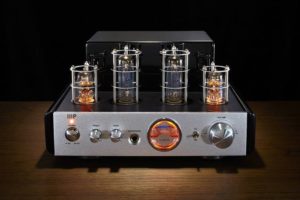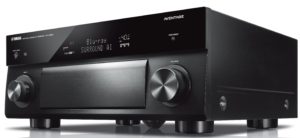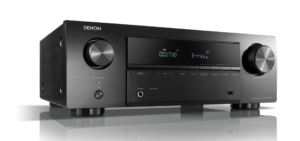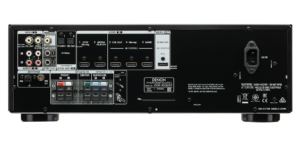
Soundbars: What You Should Be Considering
- By J. Piercy
- Jan 8, 2020



"A 9.1 surround sound system consists of nine speakers and one subwoofer. It uses two front-height channels. Therefore, with its 2 extra channels, 9.1 offers more audio depth and dimension. 5.1 and 7.1, on the other hand, only deliver a horizontal soundfield. This means audio is directed at the viewer from just one vertical plane."
In general, this creates a more 'cinematic' audio experience and a much wider range of sound. The downsides are that, of course, it is expensive, along with the fact that it requires a highly specific setup to use.
When looking at high-end televisions and audio equipment in 2019, there are a few recurring themes which might be foreign to the uninitiated. Dolby Atmos and DTS:X are two competing technologies in the audio market which are commonly seen features on new televisions and audio receivers. For those not in the know, these names might come across as arcane. Today we will cover what Dolby Atmos and DTS:X are and what makes them different.
Dolby Atmos is an audio codec which seeks to create a unique, 3D-Audio experience. Traditionally, audio is mastered for movies and music to be 2 Dimensional. Two speaker setups are the most common, and are what most televisions natively have equipped. Dolby Atmos requires use of an A/V receiver to connect your television to two pairs of speakers, mounted on the ceiling. These speakers, mounted in front of and behind the viewers, creates the sensation of three dimensional audio. Speakers created specifically to work with Dolby Atmos also exist, which remove the requirement of mounting speakers to the ceiling.
DTS:X is a slightly different take on three-dimensional audio. The key difference between DTS:X and Atmos setups are that DTS:X speakers need not be placed in specific locations. DTS:X speakers can supposedly be placed more freely, allowing for less restrictions. To add to this, there are no official requirements for the number of speakers one needs to use DTS:X.
To accomplish this feat, DTS:X speakers run a calibration during setup which assists the software in knowing where speakers are located. Through this, DTS completely avoids the most significant issue with Atmos setups. DTS:X also features a higher bitrate than that of Atmos, theoretically allowing for higher quality audio. Despite this, many listeners are unable to determine the difference in quality by ear alone. As a result, this is not necessarily something which should make up ones mind when purchasing a new device.
 The Denon AVR-X550 is a sleek, stylish take on a traditional design.[/caption]
The Denon AVR-X550 is a sleek, stylish take on a traditional design.[/caption]
 The Denon AVR-X550's rear, showing its many connection ports.[/caption]
Region Free Features
This Denon AVR-X550 was professionally modified by the experts at 220-Electronics. Units purchased from other locations are not likely to be region free. The modifications made to these units by our experts are fantastic in that they are simple to use and provide a great deal of utility. This player is ready to go out of the box once purchased from 220-Electronics. There is no obnoxious setup requiring multiple conversions. Instead, one can simply plug it in, select the correct voltage, and play their favorite discs.
Other Features
There are several other exciting components to the AVR-X550. Five speaker terminals on the back of the device allow for connection to five speakers, suiting the 5.2 support it boasts. Support for up to two subwoofers at once is also fantastic on the audio front. Five discrete power amplifiers are also a welcome feature.
Conclusion
The Denon AVR-X550 is a top-notch system that is going to meet the needs of most consumers seeking a new region-free A/V Receiver. Again, the region-free features are only guaranteed to be available when you purchase the device from 220-Electronics.com. Our in-house experts personally modify every unit shipped out to ensure their quality and functionality. If you are interested in the region-free Denon AVR-X550, you can purchase one today by following this link to 220-Electronics.com!
The Denon AVR-X550's rear, showing its many connection ports.[/caption]
Region Free Features
This Denon AVR-X550 was professionally modified by the experts at 220-Electronics. Units purchased from other locations are not likely to be region free. The modifications made to these units by our experts are fantastic in that they are simple to use and provide a great deal of utility. This player is ready to go out of the box once purchased from 220-Electronics. There is no obnoxious setup requiring multiple conversions. Instead, one can simply plug it in, select the correct voltage, and play their favorite discs.
Other Features
There are several other exciting components to the AVR-X550. Five speaker terminals on the back of the device allow for connection to five speakers, suiting the 5.2 support it boasts. Support for up to two subwoofers at once is also fantastic on the audio front. Five discrete power amplifiers are also a welcome feature.
Conclusion
The Denon AVR-X550 is a top-notch system that is going to meet the needs of most consumers seeking a new region-free A/V Receiver. Again, the region-free features are only guaranteed to be available when you purchase the device from 220-Electronics.com. Our in-house experts personally modify every unit shipped out to ensure their quality and functionality. If you are interested in the region-free Denon AVR-X550, you can purchase one today by following this link to 220-Electronics.com!  When you're looking for the best selection and the lowest prices on Multisystem Audio/Video Receivers for 220 volt use, it's important to know where to start your search. Most department stores and electronics outiftters only offer a small selection of models to choose from and carry a limited number of brands. When making purchases from these stores, you're going to end up paying higher prices for a small selection - and if you didn't know any better you might assume that's your only choice. For some people in countries with a 220 volt electrical standard, the selections are small and the prices are high since sales are lower and the demand for high quality electronics is not very prevalent. This means that anyone looking for specific model of audio/video receiver probably won't be able to find it locally. Furthermore, you can get specialized models equipped with worldwide voltage which can be used anywhere in the world.
The story is the same for anyone moving from North America to a 220 volt country for retirement, business, or long-term travel. Most likely, you'll be rather disappointed when it comes to purchasing electronics. If you're in a region where you don't speak the native language it only compounds the problem, as your struggles with finding home electronics can escalate to the point of sheer frustration. For all of these situations there's a simple solution - shopping online. The age of the internet has made it easier to find the models you want from the brands you trust, at prices much more affordable than the major stores. But where do you go? There's no better place to do it than at 220-Electronics.com, where you can browse and buy the most popular models from the top brand names and have your new audio/video receiver delivered directly to your door in practically any country in the world.
At 220 Electronics, all of our multisystem audio and video receivers are designed for use with any voltage from 110 to 240 volts. These professionally modified units (not available in department stores or major electronics stores) feature a switch on the rear allowing you to change the voltage. It's really that easy. If you're in a 220 or 240 volt country like the UK, India, UAE or China, you set your unit to 220-240 volts. If you're in a 110 or 120 volt country like the US, Canada or Mexico, simply set your receiver to 110-120 volts. There's no need for special cables or voltage converters. The are truly global receivers that can be used in any home theater in any country.
The selection of brands and models we offer include the best available such as Yamaha, Denon, Polk Audio. We also offer complete home theater packages which include items like receivers, blu-ray players, and surround sound speakers. Whatever you're after, we'll have something to suit your needs. From basic multisystem audio/video receivers to models with 4K compatibility and video passthrough, we have it all. You'll even find high-end models for the audiophiles who are serious about sound and prefer the latest and greatest in hi-fidelity technology.
So what are you waiting for? Visit 220-Electronics.com today and see the difference between our huge online store and the boring local department stores. You're going to find what you're looking for at a price you can afford. If you find it cheaper somewhere else, we'll beat that price, guaranteed. With over 40 years in business and tens of thousands of customers served, you can't go wrong.
When you're looking for the best selection and the lowest prices on Multisystem Audio/Video Receivers for 220 volt use, it's important to know where to start your search. Most department stores and electronics outiftters only offer a small selection of models to choose from and carry a limited number of brands. When making purchases from these stores, you're going to end up paying higher prices for a small selection - and if you didn't know any better you might assume that's your only choice. For some people in countries with a 220 volt electrical standard, the selections are small and the prices are high since sales are lower and the demand for high quality electronics is not very prevalent. This means that anyone looking for specific model of audio/video receiver probably won't be able to find it locally. Furthermore, you can get specialized models equipped with worldwide voltage which can be used anywhere in the world.
The story is the same for anyone moving from North America to a 220 volt country for retirement, business, or long-term travel. Most likely, you'll be rather disappointed when it comes to purchasing electronics. If you're in a region where you don't speak the native language it only compounds the problem, as your struggles with finding home electronics can escalate to the point of sheer frustration. For all of these situations there's a simple solution - shopping online. The age of the internet has made it easier to find the models you want from the brands you trust, at prices much more affordable than the major stores. But where do you go? There's no better place to do it than at 220-Electronics.com, where you can browse and buy the most popular models from the top brand names and have your new audio/video receiver delivered directly to your door in practically any country in the world.
At 220 Electronics, all of our multisystem audio and video receivers are designed for use with any voltage from 110 to 240 volts. These professionally modified units (not available in department stores or major electronics stores) feature a switch on the rear allowing you to change the voltage. It's really that easy. If you're in a 220 or 240 volt country like the UK, India, UAE or China, you set your unit to 220-240 volts. If you're in a 110 or 120 volt country like the US, Canada or Mexico, simply set your receiver to 110-120 volts. There's no need for special cables or voltage converters. The are truly global receivers that can be used in any home theater in any country.
The selection of brands and models we offer include the best available such as Yamaha, Denon, Polk Audio. We also offer complete home theater packages which include items like receivers, blu-ray players, and surround sound speakers. Whatever you're after, we'll have something to suit your needs. From basic multisystem audio/video receivers to models with 4K compatibility and video passthrough, we have it all. You'll even find high-end models for the audiophiles who are serious about sound and prefer the latest and greatest in hi-fidelity technology.
So what are you waiting for? Visit 220-Electronics.com today and see the difference between our huge online store and the boring local department stores. You're going to find what you're looking for at a price you can afford. If you find it cheaper somewhere else, we'll beat that price, guaranteed. With over 40 years in business and tens of thousands of customers served, you can't go wrong.
 Home theater systems have come a long way in recent years. What began as a TV with surround sound speakers and a basic audio/video receiver or equalizer has evolved into a highly versatile media system, capable of interacting with a variety of other devices and data. Just 15 years ago we used to boast about how real our surround sound seemed during an action movie. Today we can watch the movie without a disc by streaming in 4k Ultra HD over a high-speed wireless internet connection. We have Blu-ray Players with internet browsers and apps, TVs with voice control and multi-room audio controlled by centrally located audio/video receivers. We can use our smartphones to control the volume or change media from other parts of our homes and we can wirelessly send home videos to our Smart TVs for easy family viewing. We're living in an age of rapidly advancing technology and 220 volt audio/video receivers are just one of the many conveniences we're able to use for our multi-media enjoyment.
Home theater systems have come a long way in recent years. What began as a TV with surround sound speakers and a basic audio/video receiver or equalizer has evolved into a highly versatile media system, capable of interacting with a variety of other devices and data. Just 15 years ago we used to boast about how real our surround sound seemed during an action movie. Today we can watch the movie without a disc by streaming in 4k Ultra HD over a high-speed wireless internet connection. We have Blu-ray Players with internet browsers and apps, TVs with voice control and multi-room audio controlled by centrally located audio/video receivers. We can use our smartphones to control the volume or change media from other parts of our homes and we can wirelessly send home videos to our Smart TVs for easy family viewing. We're living in an age of rapidly advancing technology and 220 volt audio/video receivers are just one of the many conveniences we're able to use for our multi-media enjoyment.
 Denon is a brand known for their high quality and superior performance. We're happy to announce that we now have the newest Denon audio/video receivers in stock here at 220 Electronics and they're designed specifically for 220 Volt use. These 7.2-channel units come with an impressive array of features to improve both the flexibility and performance of your home theater system.
The 220 Volt Denon Audio/Video Receivers we currently have available are the Denon AVR-X1300W, Denon AVR-X2300W and the AVR-X3300W. You can see them all and get your own here. Each unit comes equipped for 7.2-channel surround sound, 4K and 3D Pass-through, and built-in 2.4Ghz dual-band Wi-Fi. The wattage output and other features of each unit vary by model, from 80 watts to 105 watts per channel. Depending on your setup, connection requirements and desired capabilities, these units range from $599 to $999.
Denon hasn't left anything out with these receivers, including the ability for multi-room audio and video that extends your home theater into other rooms or areas of your house. All of the units are DLNA ready, making it easy to access media files from other devices connected to your home network. They're also equipped with support for your favorite music apps and services like Spotify, Pandora, SiriusXM radio, and vTuner internet radio. Apple Airplay is supported, as is Bluetooth, making it a breeze to rapidly access your favorite tunes. Decoding for high definition audio comes standard, including Dolby DTS, DTS:X, Dolby Atmos and more.
All of our 220 Volt Denon Audio/Video Receivers feature a intuitive, full-color on-screen user face for easy setup and management. The Denon AVR App is another bonus, giving you the ability to control your receiver directly from your smartphone or tablet from anywhere in the house - a really great feature that comes in handy when you want to change the song or adjust the volume from another room, or even from outside your home.
While these receivers all feature support for 4K and 3D, they're also HDR ready, ensuring that you experience the best picture possible in combination with your HDR TV and Blu-ray Player. They're loaded with inputs and outputs, which of course vary depending on the model. There's something for every home theater setup imaginable. The 220 volt Denon Audio/Video Receivers have no problem acting as a central hub for optimizing all of your home theater components. If you want more control, better tuning and improved audio and video quality, you owe it to yourself to take a look at these receivers.
Denon is a brand known for their high quality and superior performance. We're happy to announce that we now have the newest Denon audio/video receivers in stock here at 220 Electronics and they're designed specifically for 220 Volt use. These 7.2-channel units come with an impressive array of features to improve both the flexibility and performance of your home theater system.
The 220 Volt Denon Audio/Video Receivers we currently have available are the Denon AVR-X1300W, Denon AVR-X2300W and the AVR-X3300W. You can see them all and get your own here. Each unit comes equipped for 7.2-channel surround sound, 4K and 3D Pass-through, and built-in 2.4Ghz dual-band Wi-Fi. The wattage output and other features of each unit vary by model, from 80 watts to 105 watts per channel. Depending on your setup, connection requirements and desired capabilities, these units range from $599 to $999.
Denon hasn't left anything out with these receivers, including the ability for multi-room audio and video that extends your home theater into other rooms or areas of your house. All of the units are DLNA ready, making it easy to access media files from other devices connected to your home network. They're also equipped with support for your favorite music apps and services like Spotify, Pandora, SiriusXM radio, and vTuner internet radio. Apple Airplay is supported, as is Bluetooth, making it a breeze to rapidly access your favorite tunes. Decoding for high definition audio comes standard, including Dolby DTS, DTS:X, Dolby Atmos and more.
All of our 220 Volt Denon Audio/Video Receivers feature a intuitive, full-color on-screen user face for easy setup and management. The Denon AVR App is another bonus, giving you the ability to control your receiver directly from your smartphone or tablet from anywhere in the house - a really great feature that comes in handy when you want to change the song or adjust the volume from another room, or even from outside your home.
While these receivers all feature support for 4K and 3D, they're also HDR ready, ensuring that you experience the best picture possible in combination with your HDR TV and Blu-ray Player. They're loaded with inputs and outputs, which of course vary depending on the model. There's something for every home theater setup imaginable. The 220 volt Denon Audio/Video Receivers have no problem acting as a central hub for optimizing all of your home theater components. If you want more control, better tuning and improved audio and video quality, you owe it to yourself to take a look at these receivers.
 A good audio/video receiver can make the difference between watching a movie and having a rich, lifelike home theater experience. With today's rapidly evolving home theater technology, it's easier than ever before to create a personalized theater system that delivers excellent audio and video quality in the comfort of your own home. There are a variety of manufacturers constantly working to create audio/video receivers with high definition audio and video compatibility that work flawlessly with the latest speaker, TV and Blu-ray technology.
A good audio/video receiver can make the difference between watching a movie and having a rich, lifelike home theater experience. With today's rapidly evolving home theater technology, it's easier than ever before to create a personalized theater system that delivers excellent audio and video quality in the comfort of your own home. There are a variety of manufacturers constantly working to create audio/video receivers with high definition audio and video compatibility that work flawlessly with the latest speaker, TV and Blu-ray technology.
 If you know anything about audio, you know that Yamaha is a highly respected contributor to the continued progression and perfection of high-qulity audio components. Yamaha actually has an old (and often forgotten) slogan; "Tuned to Perfection". This all encompassing phrase applies to everything Yamaha - from motorcycles to pianos - and it's still true today, as Yamaha is consistently on the cutting edge.
In the current audio/video scene, the market is saturated with components of mediocre design and quality. Luckily, with their decades of experience, Yamaha has stepped up to deliver some of the finest audio/video receivers currently available - The Yamaha AVENTAGE Series.
If you know anything about audio, you know that Yamaha is a highly respected contributor to the continued progression and perfection of high-qulity audio components. Yamaha actually has an old (and often forgotten) slogan; "Tuned to Perfection". This all encompassing phrase applies to everything Yamaha - from motorcycles to pianos - and it's still true today, as Yamaha is consistently on the cutting edge.
In the current audio/video scene, the market is saturated with components of mediocre design and quality. Luckily, with their decades of experience, Yamaha has stepped up to deliver some of the finest audio/video receivers currently available - The Yamaha AVENTAGE Series.
 Built with high-quality components and designed with rigid construction, the 220 volt Yamaha AVENTAGE Receivers are built to last a lifetime. They come power-packed with the latest audio and video features, including compatibility with the latest formats. Designed to merge flawlessly with your 4K Ultra HD TV, the AVENTAGE Series receivers feature support for true 4K video and 3D passthrough. With an array of setup options, you're going to get the perfect picture each and every time.
As pointers of audio, there's definitely no shortage of audio features. All AVENTAGE Series models include support for streaming wireless media from your smartphone or tablet as well as DLNA compatibility which makes it possible to share your media playlists from other devices on your home network. If you're looking for more than just the basic home theater, you can even route your audio to other rooms in your home with Yamaha's multi-zone audio feature. The AVENTAGE models also come equipped with built-in support for a variety of popular streaming media sources such as Pandora, Spotify, SiriusXM Radio and more.
Popular Features Include:
• 4K and 3D Video Compatibility
• Support for the Latest Audio Technology including all DOBLY and DTS-HD formats.
• Built-in Bluetooth and Wi-Fi (with select models)
• Apple AirPlay Ready
• YPAO (Yamaha Parametric Room Acoustic Optimizer)
• Multi-Zone Audio Support
• MusicCast for Flawless Streaming Media Support
• Cinema DSP HD3 for Enhanced Dimensional Audio Performance
• 4K, HDR, and BT.2020 Compatibility
• 4K/60p (4:4:4) Playback
• Wide Range of Audio/Video Inputs and Outputs
Built with high-quality components and designed with rigid construction, the 220 volt Yamaha AVENTAGE Receivers are built to last a lifetime. They come power-packed with the latest audio and video features, including compatibility with the latest formats. Designed to merge flawlessly with your 4K Ultra HD TV, the AVENTAGE Series receivers feature support for true 4K video and 3D passthrough. With an array of setup options, you're going to get the perfect picture each and every time.
As pointers of audio, there's definitely no shortage of audio features. All AVENTAGE Series models include support for streaming wireless media from your smartphone or tablet as well as DLNA compatibility which makes it possible to share your media playlists from other devices on your home network. If you're looking for more than just the basic home theater, you can even route your audio to other rooms in your home with Yamaha's multi-zone audio feature. The AVENTAGE models also come equipped with built-in support for a variety of popular streaming media sources such as Pandora, Spotify, SiriusXM Radio and more.
Popular Features Include:
• 4K and 3D Video Compatibility
• Support for the Latest Audio Technology including all DOBLY and DTS-HD formats.
• Built-in Bluetooth and Wi-Fi (with select models)
• Apple AirPlay Ready
• YPAO (Yamaha Parametric Room Acoustic Optimizer)
• Multi-Zone Audio Support
• MusicCast for Flawless Streaming Media Support
• Cinema DSP HD3 for Enhanced Dimensional Audio Performance
• 4K, HDR, and BT.2020 Compatibility
• 4K/60p (4:4:4) Playback
• Wide Range of Audio/Video Inputs and Outputs